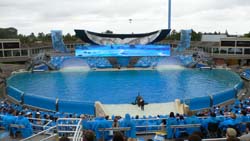Killer System

- SAN DIEGO, CA-San Diego's Sea World recently created a new show for its killer whales called "Believe" for its Shamu Stadium. To achieve such a complex system that could hold up under weather and salt water Don France, the show's producer, contracted Bill Platt of local Platt Designs to put together a sound system that would provide adequate coverage.
Shamu Stadium's new show "Believe" features a Meyer Sound System of MILOs and M3Ds to provide coverage while keeping the sound from reflecting off the water before it reached the audience.
There were several challenges Platt had to address before taking on such a task. Since Shamu Stadium is an outdoor venue, the main problem was sound bleeding into other areas; in the older show sound had been seeping into neighborhoods miles away. The stadium itself is 170 degrees wide, and the first hundred feet from the stage is over water. Platt had to design the system to keep sound off the reflective water, leaving him about 20 degrees to work with. To narrow the throw of the speakers, he chose line arrays to hit all the seats and keep the prism effect down.
Platt used several devices to predict how the speakers would perform in such a narrow spectrum. "Meyer Sound has a tool called Map that I used," said Platt. "I was able to put a Map prediction of the speaker's throw together to focus this energy on the seating correctly." Platt chose Meyer's MILO speakers for the main system and M3Ds as cardioid subwoofers based on their throw.
"We didn't want a lot of low end going into other shows," said Platt. They were hung in a split, with the MILOs on top of the M3Ds. Despite it being a left-right system, Platt's team focused it to be a mono playback system. "The problem when you put two split arrays far apart is the seam down the center. So we designed a very accurate hanging frame that would allow us to move the speakers within fractions of an inch in the horizontal point."
To attend to the gaps in the coverage Platt added a couple fills. "Because it was 170 degrees wide, both line arrays couldn't hit all the seats on the end. So I chose to hit the center seats and then I had delay speakers to hit the outside fills. I used an MSL4 for the long throw to the upper seating and I used a CQ2 for the lower seating on each side. We put those in the left and right lighting towers. All the Meyers were self powered speakers, so that eliminated a lot of issues as well."
For audio control and preset programming, Platt bought a Yamaha DM1000. "We would premix tracks through Protools and then set them into playback tracks, dumping them into the video playback unit so audio would come off the video playback. We also used Electrosonic wirelesses for the performers based on their waterproof state," Platt recalled. For signal processing, Platt also chose the Meyer Galileo.
Platt also chose FiberPlex's LightViper 1832 for a snake to the stage. "The LightViper was able to get sound down to the stage area and then we used copper to the speakers from the Galileo. We used the LightViper because it was a good transparent system, something that had high bandwidth and could work with analog and digital into the box. I also chose it because of the number of channels and sampling rates I needed. We ended up with digital audio we preamped on stage coming to the mixer without signal loss."
For final adjustments, Platt used Meyer's Sim3 to analyze the output of the system. He then utilized Meyer's ROMS, a metering system for the Meyers, which evaluated whether the cabinets were wired correctly and inline. Platt attributed much of the success of the system to these tools. "What we confirmed with SIM was that the predictive analysis was actually what we were getting. The fact that the manufacturers are spending so much time making high-resolution analysis tools to optimize their cabinets gives me more time now to focus on the creative content and quality, greatly enhancing the technical side of our work."
A daily selection of the top stories for AV integrators, resellers and consultants. Sign up below.
Platt had to deal with the environment of the whale tank as the crew installed the speakers. Because of the salt water that would be splashing all over the gear, they had to hire Oceaneering, a company specializing in salt waterproof gear. They built the set and scenic pieces out of a stainless steel, even constructing the stage so it could rotate 180 degrees for maintenance. FiberPlex provided its own salt waterproof box for its LightViper.
Platt's team also had to deal with the whales themselves during the install. "We had no room for error and nothing could be loose. If you dropped one bolt in the water a whale could swallow it. We were on a bridge between the performance and holding tank, so they literally came up and watched us while we were doing the install."
